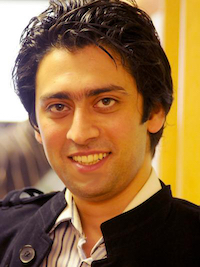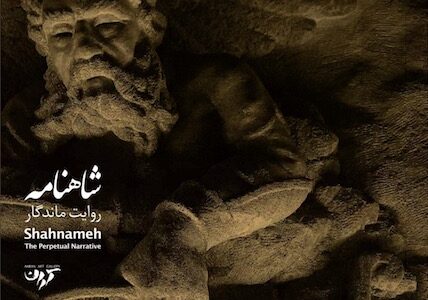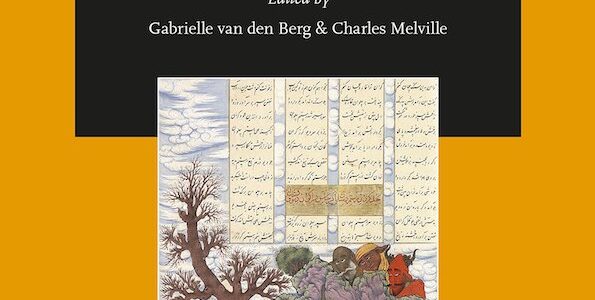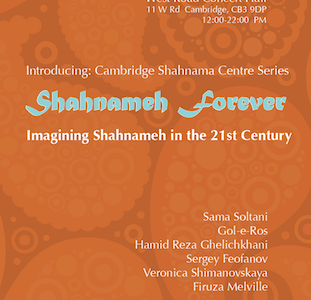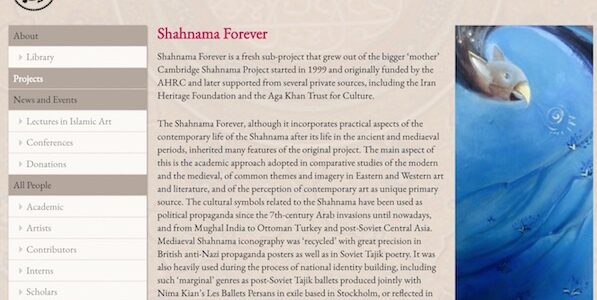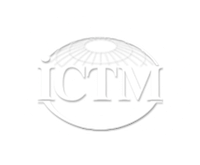«رستاخیز شهریاران ایران» از میرزاده عشقی اولین اپرای ایرانی به حساب میآید، اگرچه بر مبنای معیارهای جهانی باید آنرا یک «موزیکال» و یا «اپرت» به حساب آورد. میرزاده عشقی این اثر را در ۲۲ سالگی پس از بازدید از ویرانههای کاخ مدائن، در عراق امروزی، در جریان سفرش به ترکیه در سالهائی که در شهر…
رستاخیز شهریاران ایران اولین اپرای تاریخ ایران اثر میرزاده عشقی در لندن به روی صحنه خواهد رفت
بسیاری «رستاخیز شهریاران ایران» میرزاده عشقی را اولین اپرای ایرانی میدانند، اگرچه بیشتر به تئاتری موزیکال یا به گفته خود او «نمایش آهنگین» شباهت دارد. میرزاده عشقی نویسنده و شاعری است که نامش با جنبش مشروطه گره خورده است. «رستاخیز شهریاران ایران» او منظومهای است در سوگ فروپاشی حکومت ساسانیان. در این «نمایش آهنگین» پادشاهان…
Avicenna : “The Pain of Existence , Hossein Hadisi” – ابوعلی سینا – محنت وجود – حسین حدیثی
Poetry by Avicenna: The Pain of Existence Do you know why a child doesn’t owe her father anything Even if he provided for her day and night? It’s because in this world of accidents, It is you who has given me the pain of existence. Guitar: Marco Duranti, Viola: Kinga Kowalczyk, Tenor Recorder: Máté Szgeti,…
Shahnameh, The Perpetual Narrative
…It is remarkable that Akram Ahmadi Tavana, the author of this survey, an artist in her own right, also focuses on the image of Zahhak as the idea of the evil which exists among us in the shape of a human being of a common origin. Ahmadi Tavana’s interpretation of Zahhak of our days is…
The Reception of Shahnama, Shahnama Series Vol. III
The image of Zahhak as a symbol of tyranny to be overthrown however strong he is, has been popular in Iran and outside the country among the Persian communities all over the world until nowadays. Among the latest examples of this are the plays and musical performances in Europe (Till Uilenspiegel) and the U.K. (The…
Imagining Shahnameh in the 21st Century
3T hree years ago Cambridge joined the world celebrations of the Millennium of the Shahnameh in the version of Ferdowsi, thePersian hereditary aristocrat who for half his life was writing his bible:a legendary, heroic and romantic chronicle of his country since thecreation of the world until the Arab invasion in the 7th century.Ferdowsi’s cult poem Shahnameh, which can be…
Shahnama Forever
Shahnama Forever is a fresh sub-project that grew out of the bigger ‘mother’ Cambridge Shahnama Project started in 1999 and originally funded by the AHRC and later supported from several private sources, including the Iran Heritage Foundation and the Aga Khan Trust for Culture. The Shahnama Forever, although it incorporates practical aspects of the contemporary…
International Council for Traditional Music
Report of the 3rd Symposium of the ICTM Study Group on Music of the Turkic-speaking World Groups audience: ICTM Study Group on Music of the Turkic-speaking World “Popular Culture in Turkic Asia and Afghanistan: Performance and Belief” was the subject of the 3rd Symposium and Workshop of the ICTM Study Group on Music of the Turkic-speaking…
Pembroke Centre for Persian Studies
The Pembroke Centre for Persian Studies has grown out of the Cambridge Shahnama Project (currently 1 Fitzwilliam Street, Cambridge CB2 1QH), and represents the fulfilment of one of the original aims of that project, to promote Persian studies in Cambridge and the UK more generally. Its start is associated with the opening of the Shahnama…
The Pembroke Shahnameh Centre for Persian Studies
Pembroke Shahnameh Centre for Persian Studies has grown out of the Cambridge Shahnama Project (currently 1 Fitzwilliam Street, Cambridge CB2 1QH), and represents the fulfilment of one of the original aims of that project, to promote Persian studies in Cambridge and across the UK. Its activities include termly lectures on Persian and Islamic art, academic conferences and publications and other cultural events, like art exhibits and…
Postdoctoral Research at Darwin College, University of Cambridge
During the past twelve years, I have collected a big archive of Middle Eastern modes and scales (i.e. Maqáms) in the form of scores, recordings and text. The Maqám Encyclopaedia project aims to turn this raw data into a dynamic database where the users can view the overall structure and the relationships between different Maqáms, as well as studying one particular Maqám in detail and compare different renditions of it. Once the platform is made, the database goes live online in the format of an administrator-monitored wiki, where users can submit more entries and samples, which will be added to the database after being reviewed by the administrators.
The collection includes recordings, scores and books and articles about the various schools and traditions within Persian musical traditions. I am using an assistant in the UK and one in Iran to tag the data as it is collected. The raw data is analysed and categorised according to its source, media type, related topics, cultural and linguistic root and many more categories that allow a multi-dimensional relationship between data. This means that unlike the traditional categorisation method, which varies from culture to culture or in different historical periods, the musical modes and melodies can be explored in any desired way. The views can vary from all the references to the melody known as “Oj” (peak, climax) in Hafiz’ poetry to the map showing geographical distribution of Kurdish dance rhythms in the region.
For centuries, much of Middle Eastern music has been taught using aural methods. Because of the improvisatory nature of this music, a universal notation system was never established and musicians did not write and document their work. After the introduction of Western notation, invention of recording technologies and the beginning of ethnomusicological, various accounts of Middle Eastern modes and songs where made. The discrepancies between different versions of the same material resulted in confusion and repetition in naming and classification of the musical material. Different schools of improvisation refer to the same phenomenon using different terminology or use the same word to describe different objects. There is a dire need for a comparative and comprehensive reference on Middle Eastern musical Maqáms.
I am going to digitalise and classify an otherwise vastly varied and disorganised collection and make it accessible to ethnomusicologists, learners and teachers. The project will provide an online platform for comparing different performances of a single piece and interrelate information, terminology and etymology behind the Maqáms, for the first time ever. The encyclopaedia can be used as a learning tool, as well as a valuable academic one and engages the viewers by allowing participation on their part.
Data analysis consists of unifying Persian and English titles for the available data, tagging and marking audio recordings by artist, musical mode, year of recording, publisher (if available), recording medium, length and quality. Scores are all scanned as preserved as digital copies and categorised by similar tags plus bane of scholar who has notated them and properties relevant to the style. The majority of the research project is dedicated to studying the literature and indexing all the available data. This has started with emphasis and focus on available music dictionaries, encyclopaedia, Persian dictionaries and other similar resources. All this work has been done in the first year of the project (2015) and the overall database structure was established. Once the all the available data in the primary resources are marked, scanned, typed-in manually and tagged, the second phase of literature review will start. In the second phase in 2016 (after the proposed research trip), all the other secondary musical resources that have any mention to a musical mode are similarly marked and analysed. This collection consists of roughly 120 resources that make up the essential collection of scholarly books available on the subject of Persian Dastgah, Radif and melodies.
By expanding the collection in 2016 to include similar resources on folk music, phase three will start in the following year. In the third and final year of the project, we will include articles and any non-musical text that contain data related to the database and allow user uploads. The administrators monitor and authorise addition of user information under a separate heading at the end of the wiki article for each entry. At the same time, phase one for folk music and non-Persian music data entry starts. The wiki-style webserver will be monitored and upgraded regularly after the end of the third year and it is expected that both the database and the interface will be stable and finalised and won’t require much maintenance for the near future.
My proposed research trip to Iran will help me continue my research with my colleagues Dr. Hooman Asadi of Tehran University, Dr. Hossein Imani, Dean of Culture University, Dr. Narges Zakeri of Gilan University, MohammadReza Darvishi and the prominent Iranian composer Loris Tjeknovarian. Dr. Asadi has access to private archives including manuscript of transcribed modes by the scholars in 1960-70s in the library of Tehran University and archive of the Department of Music. My associate, Dr. Narges Zakeri is helping me with data analysis and meticulous literature review. My academic advisors are Professor Nicholas Cook (University of Cambridge) and Professor Michael Finnissy (University of Southampton) and my IT advisor at the Faculty of Music, Cambridge, Mr. Mustafa Beg, helps me with issues concerning the servers. University of Cambridge has dedicated a URL and server space for the Maqam project database and server. The servers are currently running on a test mode (beta) with full functionalities available on the local servers.
The technology used for the project is MediaWiki, the engine behind many online encyclopaedias, such as Wikipaedia, itself. Copyright consent for partial or complete display of scores, books and recorded material has been obtained with the main publishers and Mahoor Institute of cultural Studies and Iran Music Associations are happy to help us with online linking to their resources and products on websites and services such as iTunes, Amazon, etc. My undergraduate studies were in Computer Science and I have created the database and the interface from scratch. I will continue to act as the web and database administrator, as well as the chief editor of the project in the future.
As an ethnomusicologist and composer, I have been fascinated by the differences in each performance of a given mode and have studied different schools’ and tribes’ approach to the same material. Improvisers master the fundamental techniques of variation and ornamentation in order to renew the material and make it their own. On the other hand, for learners, beginners and researchers, there is no way to identify each musical subject using the same reference. One of the main objectives in my postdoctoral research on “Compositional Methods in the Middle Eastern Improvisation” at the Faculty of Music has been to study the similarities and differences between different renditions of the Middle Eastern Maqáms. Lack of a comprehensive and comparative reference is felt much more as interest and depth of research increases in this field of Ethnomusicology. I believe with my background as a Computer Science graduate, with an MMus and PhD in Music, I can put my knowledge of the two fields in practice by creating a dynamic database of Middle Eastern Maqáms, represented in the form of an online encyclopaedia….
PhD in Music Composition at University of Southampton
The spiritual journey of many greatly influential figures throughout history has been subject to physical journeys. The enlightening visions and experiences that prophets, poets and thinkers have witnessed have given birth to new intellectual horizons that might not have been achieved, but for the challenges and adventures entwined with the nature of migration.
The musical journey of my life, too, has been affected by the physical and spiritual journey I have made by leaving Iran. The nature of Persian music, also, takes one on a mystical journey of self-analysis and awareness. Inevitably, my music is the product of the culture I was raised in and the ones I have had the privilege of living in. My interpretation of these cultures, hermeneutics of humanities and understanding of music, is also strongly influenced by my personality and psychological characteristics. As a composer, I have always refrained from commenting on my own music. I find the experience somewhat challenging, yet amusing, non-musical, yet poetic and unnecessary, yet fruitful. In writing this commentary, I have re-visited some of the most intimate compositional experiences I have had and I am grateful for the depth of insight provided by this experience….
MMus at University of Southampton
“Existing where there is nothing, is the meaning of the phrase: “Form is Emptiness.”
That all things are provided for by nothingness, is the meaning of the phrase: “Emptiness is Form.”
One should not think that these are two separate things.”
-Hagakure: The Book of the Samurai
This portfolio has benefited from the generous teachings of Professor Michael Finnissy, Dr. Michael Zev Gordon and Dr. Andrew Fisher.
I thank them all for their great support and
dedicate these pieces to Pegah Salimi….
